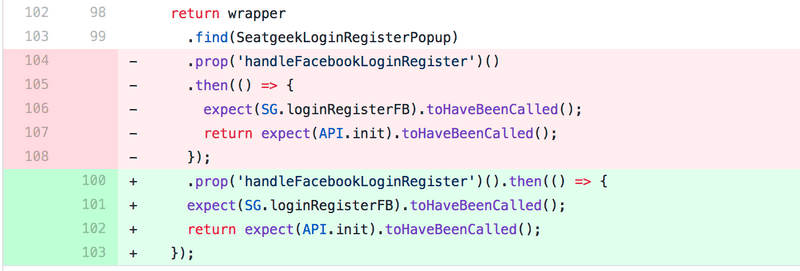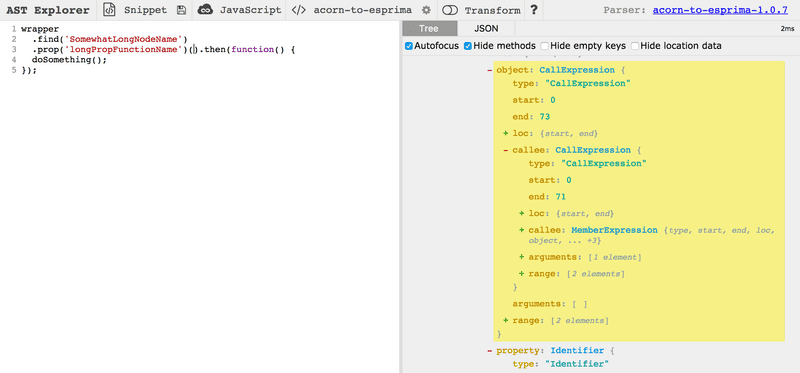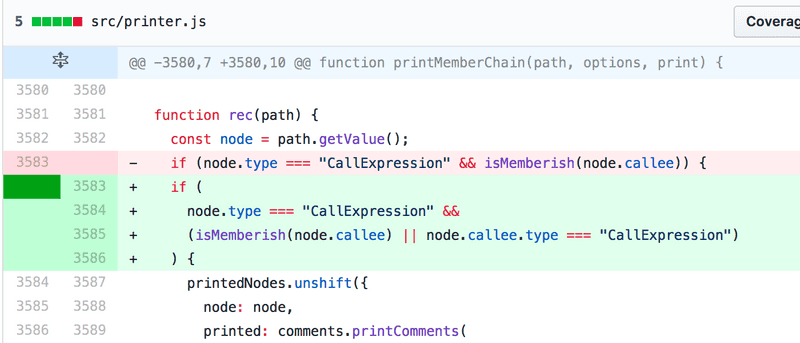Prettier has changed my life. I wanted to learn more about how it worked, so I decided to take on a minor formatting bug I found in the most recent release. I've been wanting to spend more time documenting how I approach problems and learn new things, and this post is the result of that process.
So how does Prettier make my code, well, prettier?
Admittedly I only have a vague understanding of how Prettier works internally. What I know right now is that is has some means of parsing JavaScript (and other languages!) and reprinting it according to a predefined standard. In other words, magic, right?!
From the docs:
The basic idea is that the printer takes an AST and returns an intermediate representation of the output, and the printer uses that to generate a string. The advantage is that the printer can "measure" the IR and see if the output is going to fit on a line, and break if not.
That sentence is a lot to grok, but the gist is that for code to be formatted, it's put through a pipeline that looks roughly like this:
- Code is parsed and represented in a tree notation called an abstract syntax tree (AST). AST Explorer has a fantastic interactive demonstration for what this looks like. It's really cool seeing how your code is understood by the parser, and how a deceptively simple example can expand into hundreds of nodes on the tree.
- A
printeruses that syntax tree to produce some kind of output that can be measured for length. I'm a little unclear on what the "intermediate representation" is or how that relates to the final output, but it's key to how Prettier works. - The
printerdetermines what can fit on the line and introduces line breaks to fit within the limit.
This is a very simplified look, since Prettier does quite a bit more, like attempting to preserve some style choices that already exist in the code.
A wild bug appears! 🦋
At SeatGeek we've been rolling out Prettier across our entire frontend codebase. I was upgrading it to a new version and came across a questionable change in one of our Enzyme tests:

It's harmless enough — the promise didn't make it onto a new line, and the indentation for the callback in the promise's call expression broke. But functionally it was still the same, so we proceeded with the upgrade and filed an issue with that context.
Side note: filing issues for Prettier is amazing. Their playground has a really handy button that opens a GitHub issue with the input and output already filled in. The authors have clearly put a ton of thought into creating a really solid developer experience.
A journey in fixing
Now that I have a moderately better understanding of how Prettier works internally, I'm ready to dive into the code. To kick it off, let's fork the repo, clone it, start it up, and write a unit test for this particular case.
Prettier uses jest for testing, so setup is painless.
yarn
yarn testI see a couple warnings, but everything passes on the first run. Cool!
Figuring out where to put the test is honestly the first big challenge. I see tons of jsfmt.spec.js files in the test output, organized into directories. JavaScript tests seem to all have their own top-level directories, and other languages are filed away in subdirectories.
My test case seems to touch a few different areas, so should it go in the function directory? arrows? I don't know enough yet, so let's find an example pull request to borrow from. There are a couple candidates from the 1.7.0 release that reference member chains, and #2786 in particular seems the most promising, pointing to member and method-chain tests. Now I'm on the right track 🌟
Just for fun, let's pull some levers and see how this breaks. I'll watch the tests with...
yarn test method-chain -- --watch... and take a gander at printer.js. The size of the file is a little intimidating, but luckily the pull request from before gives me two starting points:
- There's a method called
genericPrintNoParenswith a 2,500-line switch statement that contains instructions for each node type in an abstract syntax tree. - There's another method called
printMemberChainthat immediately jumps out to me. Props to whoever wrote the documentation, because I don't have to look far to understand exactly how it works:
// We detect calls on member expressions specially to format a
// common pattern better. The pattern we are looking for is this:
//
// arr
// .map(x => x + 1)
// .filter(x => x > 10)
// .some(x => x % 2)
//
// The way it is structured in the AST is via a nested sequence of
// MemberExpression and CallExpression. We need to traverse the AST
// and make groups out of it to print it in the desired way.
function printMemberChain(path, options, print) {
// ...
}Breaking this function is oddly satisfying, because I can watch the test results come back with new and interesting ways of formatting the test cases. But even better is that it confirms I'm in the right place, and I can see exactly which test files cover this.
The test cases are super simple. An entire file is fed through the formatter, and the results are stored in a jest snapshot. So if I want to test my case, all I have to do is add it to the most sensible file (multiple-members.js seems close enough), re-generate the snapshot, manually edit the snapshot with the desired output, and tweak the printer until the tests pass.

Sweet. So now that we have a test and know approximately where the issue is, it'll help to narrow down our bug. Let's take a look again at a simplified version of the code that's breaking:
wrapper
.find("SomewhatLongNodeName")
.prop("longPropFunctionName")().then(function() {
doSomething();
});We can learn a lot about how this code is interpreted by looking at how it's parsed in AST Explorer:

The point where the formatting breaks is at these nested CallExpression nodes: ('longPropFunctionName')(). Based on my understanding of printMemberChain from reading over its code and documentation, nesting CallExpressions is already supported, so there's a bug that's preventing it from working correctly.
I wanted to better understand the inputs and outputs for each part of the printMemberChain method, so I started logging variables at certain points. Surprisingly, printMemberChain was being called twice!
I was curious how it was handling the data, so I logged out the output of the first phase, which takes a nested AST structure and flattens it. The first call to printMemberChain grouped the first part of my test case (wrapper.find(x).prop(y)), and the second call handled the end (().then(...)).
Reading over the recursive method, I realized why: the process of flattening the abstract syntax tree was only looking for two types of chains:
- Member-to-Member:
a.b.c - Member-to-Call:
a.b()
But not Call-to-Call: a.b()(). So I added in a condition to allow nested CallExpressions, and the tests passed!

In all, I spent around four hours getting up to speed on how Prettier works, tracking down the bug, and filing a pull request (and a small followup) with the one-line fix. Even though the change was so simple, I feel like I came away from this with a much better understanding of its internals, and have a huge amount of respect for everything that Prettier's authors have done to vastly improve the developer experience of the frontend ecosystem.